Subphylum Vertebrata | Higher classification Lycodon | |
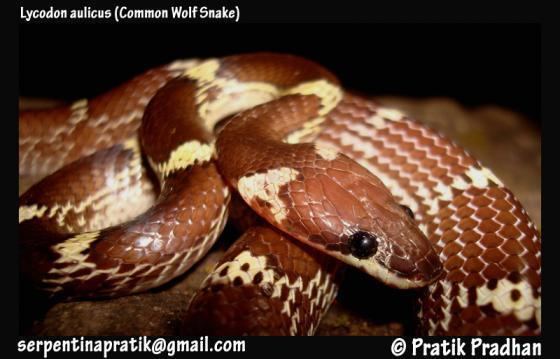 | ||
Similar Lycodon, snake, Lycodon capucinus, Reptile, Colubridae | ||
Indian wolf snake lycodon aulicus
Lycodon aulicus, commonly known as the Indian wolf snake, is a species of nonvenomous snake found in South Asia and Southeast Asia. Early naturalists have suggested its resemblance to the venomous common krait as an instance of Batesian mimicry.
Contents
- Indian wolf snake lycodon aulicus
- Wolf snake lycodon aulicus
- Description
- Scalation
- Distribution
- Behaviour
- Diet
- Reproduction
- References

Wolf snake lycodon aulicus
Description
The colouration of this snake is variable.
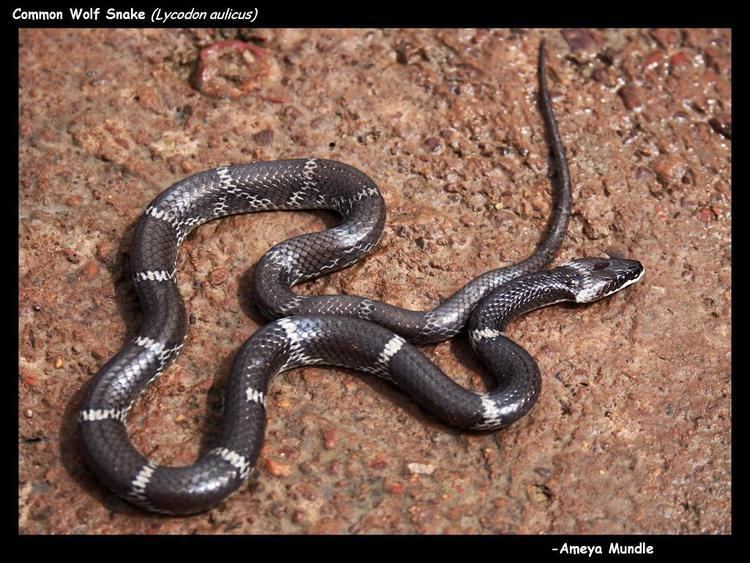
This snake is often confused with the common krait. The presence of a loreal shield can be used to distinguish it from kraits.
The following is a description of various forms from Albert Günther's Reptiles of British India (1864).
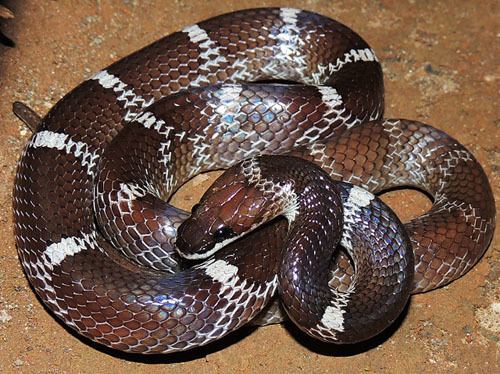
Snout broad, much depressed, long, spatulate, with the upper lip swollen, and without canthus rostralis. Rostral shield very low, broad, slightly bent backwards on the upper surface of the snout; anterior frontals [= internasals] very small; posterior frontals [= prefrontals] longer than broad, much more so in adult specimens than in young ones; there is a lateral notch between the anterior and posterior frontals, in which the inner anterior angle of the loreal is received; the posterior frontals have an obtuse lateral angle corresponding to the suture between loreal and praeocular; occipitals elongate. Nostril small, directed upwards, between two nasals, the anterior of which is situated on the foremost part of the snout. Loreal single, large, nearly twice as long as broad. Praeocular single, in contact with the vertical [= frontal] and with the third labial; specimens in which it does not reach the vertical are very scarce. Two postoculars; supraciliary rather small. Nine upper labials, the third, fourth, and fifth of which enter the orbit. Temporals numerous, scale-like. Scales smooth, with a minute apical groove, in seventeen rows. Abdomen and tail with an angular ridge on each side. Ventrals 183-209; anal bifid, in a few specimens entire; subcaudals 57-77. Each maxillary is armed with two fangs in front, placed in a transverse line, the outer being much larger than the inner; the lateral longitudinal series of teeth commences at some distance from the fangs; they are small, from four to twelve in number, the last being considerably larger than the others; pterygoido-palatine teeth small, of equal size; mandible with two or three fangs on each side and with a series of small teeth.
Coloration variable.
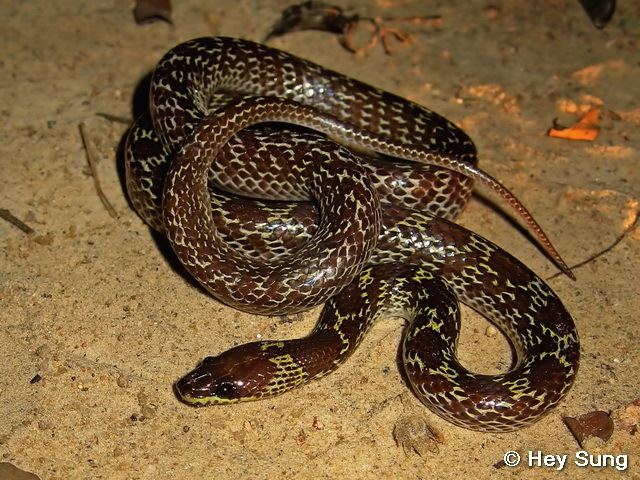
The following description is from Boulenger's Fauna of British India, Reptilia and Batrachia volume (1890):
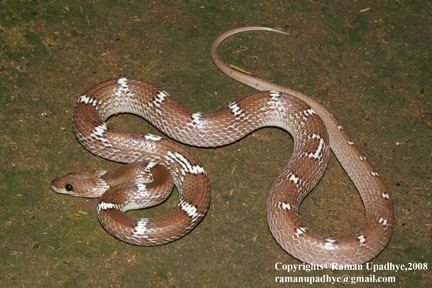
Snout much depressed, with swollen lips, spatulate in the adult; eye rather small. Rostral much broader than long, just visible from above: internasals much shorter than the prefrontals; frontal usually shorter than its distance from the end of the snout or than the parietals ; loreal elongate, not entering the eye; one praeocular, usually in contact with the frontal; two postoculars; temporals small, scale-like, 2+3 or 3+3; 9 upper labials, third, fourth, and fifth entering the eye; 4 or 5 lower labials in contact with the anterior chin-shields, which are longer than the posterior. Scales smooth, in 17 rows. Ventrals 183-209, obtusely angulate laterally; anal divided; subcaudals 57-77, in two rows. Coloration variable; uniform brown above, or with white transverse bands, or with white reticulation; upper lip uniform white, or with brown spots; lower parts uniform white.
Total length 51 cm (20 inches); tail 11 cm (4¼ inches).
Habitat: India and Ceylon, Himalayas, Burma, Siam, Malay Peninsula, Java, Philippines, Timor. A common snake in India.
Scalation
The rostral touches six shields. The frontal touches the parietals, supraoculars, prefrontals and preoculars. The supraoculars are small. The parietals are one and a half times the size of the frontal. The preoculars are entire, while the postoculars and temporals are divided into two shields. There are nine supralabials, with the 3rd, 4th, and 5th touching the eye. The ventrals are 170 to 224 in number. The anal shield is divided. The subcaudals are 56 to 80 and are divided.
Distribution
Lycodon aulicus is found in Pakistan, Sri Lanka, India (north to Himalayas and Assam; Maharashtra), Bangladesh, Nepal, Myanmar (= Burma), Thailand (incl. Phuket), W Malaysia, Indonesia (southward as far as Timor), Philippines, Seychelles, The Maldives (accidental introduction), Mascarenes, Mauritius (introduced), S China (from Fujian and Guangdong westward to Yunnan, incl. Hong Kong). It is one of the most common snakes of India and Ceylon, but becomes scarcer on the coasts of the southeastern parts of India. It occurs on only a few of the islands in the Philippines.
Behaviour
The Indian wolf snake is nocturnal and is inactive in the day. Günther (1864) writes that it is of fierce habits and defends itself vigorously, however it is nonvenomous. It is known to defend itself when barred of escape, and can cause severe lacerations with its fine sharp "fangs".
Diet
Lycodon aulicus feeds on lizards and frogs. According to Günther (1864) it is one of the most formidable enemies of the skinks, which form almost its sole food, the "fangs" in the front of its jaws being admirably adapted for piercing and making good its hold on the hard smooth scales with which those lizards are coated.
Reproduction
Females may be larger than males. They breed prior to the monsoons and lay 4-11 eggs.
The eggs hatch in September or October, and the hatchlings are 14-19 cm (5½-7⅜ inches) long.
